Brief history of the numeric keypad
- Transfer
Imagine a phone keypad and a calculator. Can you remember how they differ, without looking at them anywhere? If you do not succeed - do not worry. Most of us are so accustomed to common data entry devices that we simply do not realize that on a calculator, if we compare it with a phone, the keys are arranged in the reverse order. The top row of calculator buttons contains 7-8-9 keys, and the top row of the phone keypad contains 1-2-3 keys. The fact that these two keyboards, whether represented as physical devices or as applications, are arranged differently, cannot be discerned for any logical reasons. Why do they look that way?
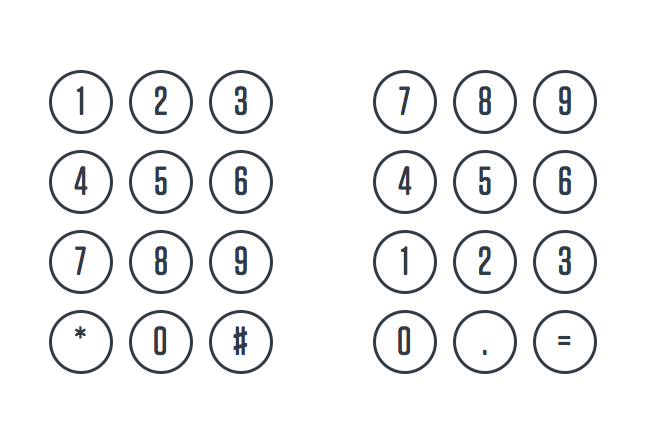
Phone keypad (left) and calculator keypad (right)
As you can see, there is an insignificant but mysterious difference between these keyboards, given that they serve the same purpose — the input of numbers. Working with these keyboards looks exactly the same, so the reason for their differences is not quite clear. Common sense suggests that some technological limitations have played a role. Perhaps the keyboard looks like this because of the patent struggle between the inventors. Someone might try to explain the difference between them with ergonomic considerations.
I believe that the answer to the question about the reasons for the differences in digital keyboards will help to find the history of the evolution of the devices with which they were supplied. Going deeper into history, we will be able to find out which device was first invented, which keyboard influenced the other, and, more importantly, who first came up with the numeric keypad.
Once I looked at the keyboard and I wanted to know when, in the history of cars, the use of keys began. The keyboard appeared roughly between the first and second industrial revolutions (between 1820 and 1920). And some inventors have already started experimenting with piano-like machines in the late 18th century.
The year of the appearance of the keyboard can be considered 1844, when the Frenchman Jean-Baptiste Schwilge created the first working prototype of a calculating machine with a keyboard. This machine used the world's first numeric keypad, which is a single row of keys with numbers from 1 to 9 on them.

The keyboard of the Jean-Baptiste Schwilge counting machine, 1844
For the sake of justice, however, two predecessors of Schwilge should be mentioned, which could be said that the human-machine interface based on the numeric keypad was invented by them. So, in 1834, Luigi Torquay, as reported, demonstrated a prototype of a wooden counting machine, the device of which resembled a typewriter. In 1822, James White, in his book “A new century of inventions ...,” described a device using a keyboard with nine numeric keys. Neither device has reached our days, we have no evidence that they were not only the fruit of someone's imagination.
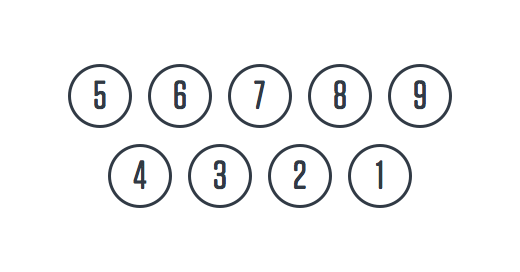
The keyboard of the counting device described by James White, 1822 The
White machine, even if it existed only on paper, may well be considered the earliest example of a modern interface with direct control. This interface allows users to focus on working with the input device, without requiring them to interact with the internal mechanisms of the machine. Such an approach differs from that used in the Pascal summing machine or in the calculator for Thomas de Colmar.
It should be noted that these "ideas" still do not give us an explanation of why modern calculators use the keyboard with the reverse arrangement of numbers from 9 to 0.
There is an opinionaccording to which calculators are designed on the model of cash registers. This is worth pondering, since the numbers that had to be entered on such machines, representing certain sums of money, contained many zeros, which made the 0 key, which was most often pressed. Therefore, it made sense to place it at the very bottom of the keyboard so that it was as close as possible to the fingers of the operator.
Although this explanation probably contains some truth, the argument, based on the fact that it is easier to reach the zero, located at the bottom of the keyboard, is rather weak and does not withstand the test of facts. This is especially obvious if we consider that in the early models of cash registers that existed before 1893, there was no separate key 0 and there was no box for cash. In addition, the work with such devices was not organized as it is now.
In order to understand the relationship of calculators with cash registers, you need to refer to the history of the latter.
In 1897, James Ritty, the owner of a bar in Dayton (Ohio, USA), found that some of his employees were stealing. One day, he saw the steamer shaft speed counter, and, impressed by this spectacle, he invented a machine that used a set of numeric keys and something like an hour dial. The ancestor of modern cash registers was not designed for calculations. He allowed to record sales information and notify them with a call to the store manager.
Early cash registers that existed before 1983 had keyboards, usually consisting of one or two horizontal rows of keys, representing values such as 10, 15, 20, 30, 35, and so on. These numbers corresponded to the prices of goods sold in stores and bars, expressed in cents. Three vertical rows of keys appeared only with the release in 1894 of the NCR Model 79.

Keyboard of the first cash register by James Ritty, 1883
It should be noted that there are earlier evidence indicating the invention of the vertical layout of keys.
In 1884, Dorr Felt had an interesting idea for a machine that could operate with large numbers. When this idea developed enough, he decided to implement it, for a start, using what was at hand, including a wooden box from under the macaroni, which played the role of the body of his car, called comptometer. Comptometer had eight columns of keys with numbers from 9 (above) to 1 (below). Each column represented a decimal position. Remember that 0 is still not present in the key sequence.
Meanwhile, cash registers continued to evolve.
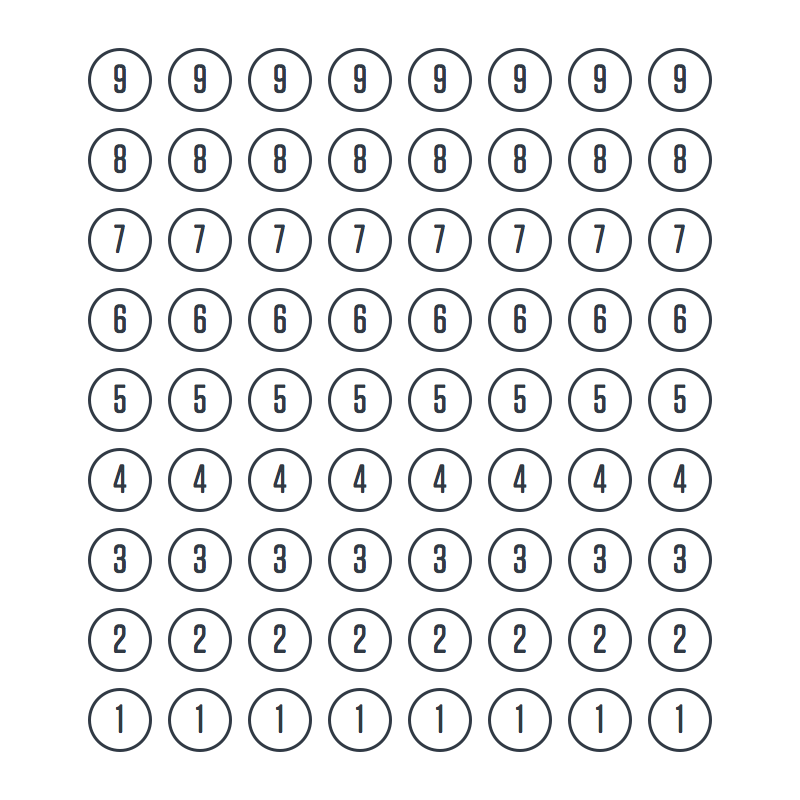
Comptometer Keyboard, 1885
And here the story is getting more interesting. Why did Felt decide to use a keyboard with a sequence of numbers from 9 to 1 to represent numbers? At that time, such an arrangement of keys could not be called familiar. In the end, then the knowledge of arithmetic machines was not particularly common.
An acceptable answer to this question can be compared with some mechanical design solutions, possibly associated with the method of additions , and with the fact that the keys set in motion the levers associated with the rotating drums. The longer the lever - the more the drum turns. The longest lever, therefore, corresponded to the number 9, and the shortest lever - to the number 1. The same principle, before Felt, applied Parmeli.
Here is another approach to answering the question about the arrangement of numbers on the keys of a comptometer. It is based on modern design principles and goes beyond the idea of explaining everything with purely mechanical features of the device. So, in accordance with the instructions for comptometer, it was assumed that the operators, in order to enter "9 cents", will not press the 9 key in the rightmost column. Instead, they would press, successively, the keys 4 and 5, and the car would add these numbers. It was not recommended to reach the key 9 in such a situation, as this would reduce the speed of calculations due to the fact that the operator would have to move the right hand, located in the lower part of the keyboard, to its upper part. Felt attached great importance to efficiency. This meant that the keys used most often had to be within the reach of the operator’s fingers. There is a feeling that the desire for efficiency led to exactly this arrangement of the keys of the comptometer, but the data entry interfaceThis machine can not be considered easy to learn and use.
To achieve maximum productivity when working with comptometer and competing machines, we needed well-trained operators. In addition, especially when it came to multiplication, it was difficult to work with such devices with one hand.
In 1902, Dalton’s calculating machine appeared , which became the most popular 10-key machine of the time, making calculators less popular and having multi-column keyboards. This device was a smaller version of a typewriter, its keys were arranged in two rows, five each. The keyboard layout looked strange: in the upper row were the numbers 24579, and in the bottom row - 13068. What is special to notice in the keyboard of this device?
Surely you already understood it. There appeared 0, which we have not seen in the previously discussed keyboards.
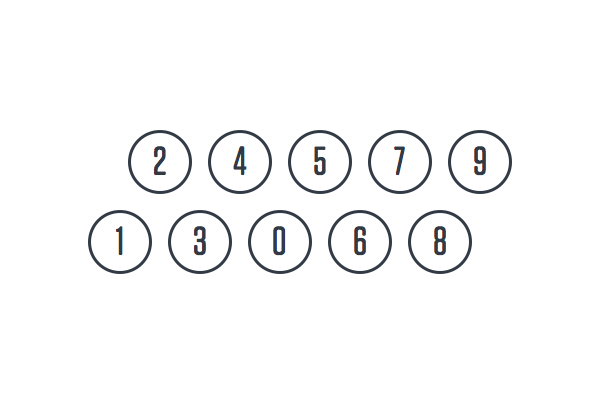
Dalton's Keyboard Machine, 1902
Dalton's machine, in addition to a new type of keyboard that does not require the use of separate keys to enter each digit of the decimal number, also had a built-in printer. Accountants around the world could not get enough of such a useful invention. But, after the appearance of this machine, the development of devices for carrying out calculations, of course, did not stop.
In 1914, David Sundstrand, an American of Swedish descent, filed a patent application (No. 1198487). The purpose of this patent was to improve the usability of summing machines. Sandstrand changed the location of the keys, making it more "logical and natural." The new keyboard layout was based on the main block of 9 keys, containing 3 keys vertically and 3 horizontally. In the very top row of this block were the numbers 7-8-9. Below this block, there was an increased 0 key. It was possible to work with such a keyboard with one hand, which made it “the fastest keyboard among the keyboards of all calculating machines”.
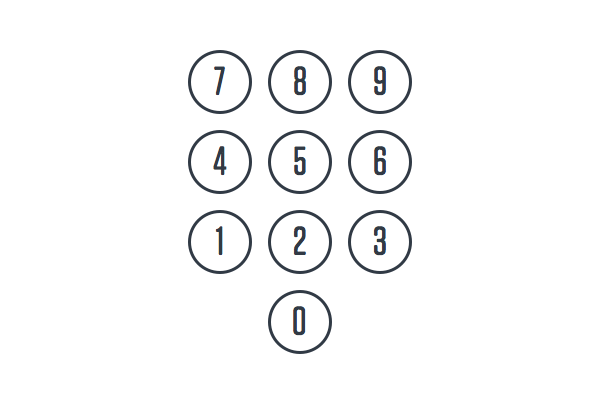
SANDSTRAND'S MACHINE KEYBOARD, 1914
It is this layout that has become the standard for calculators, which is relevant even now, when more than a hundred years have passed since its inception.
Can we say that calculators, in the course of their evolution, have influenced modern phones? Perhaps this is so, but it is impossible to give an exact answer to this question. Experiments with push-button telephones were carried out back in 1887, at Bell Telephone Company, which was at the origin of telephone communications. This was prior to the invention of the disk dialer by Elmon Brown Strouger. The company Western Electrics entered the commercial operation of the device in 1919. This continued until the 1950s, when the automatic long-distance telephone service significantly spread. Local numbers (usually consisting of six or fewer digits) have been expanded to seven-digit numbers. Long-distance call led to the need to dial 11 numbers.
Increasing the length of phone numbers has increased the number of errors when making calls, which made AT & T engineers think about whether this is due to the inconvenience of the keyboard used by telephone service operators .
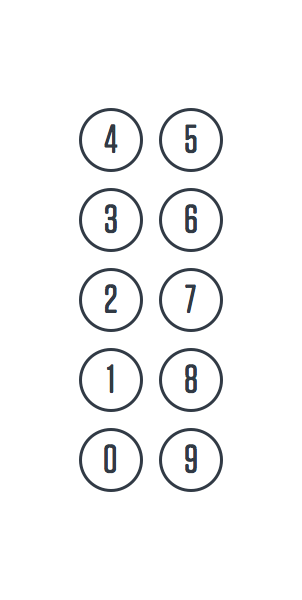
The keyboard layout used in telephone services in the 1950s
In 1955, a study was conductedconcerning the arrangement of characters on a ten-button keyboard, then, in 1960, another similar study of telephone keyboardswas carried out. The findings of these studies contained information that could have an impact on the design of a modern phone. AT & T was going to switch to tone dialing, which implied the use of devices equipped with a keyboard for dialing. It was important to determine what configuration of the keyboard is best suited for subscribers.

Keyboard layouts tested in a 1960 study.
The company experienced 15 layouts using, among other things, unusual looking diagonal, pyramidal, circular, and horizontal ways of organizing keys. This included the layouts used in existing devices, such as calculators and punchers like the IBM Model 011. Unexpectedly, the calculator's keyboard did not perform well here. The subjects preferred the keyboard, on which the numbers are located from left to right and from top to bottom.
In particular, working with a 2-row horizontal keyboard (5-5-H) was just as fast as with a modern looking keyboard with a 3x3 + 1 layout, the differences between them were very small. AT & T chose the 3x3 + 1 layout, perhaps because it is more compact and versatile.
Note the word "possible" in the previous sentence. It is useful to us and a little lower. Both studies did not give a definitive answer to the question of the perfect keyboard. And in the UK they started using the 5-5-H type keyboard, possibly due to patent restrictions.
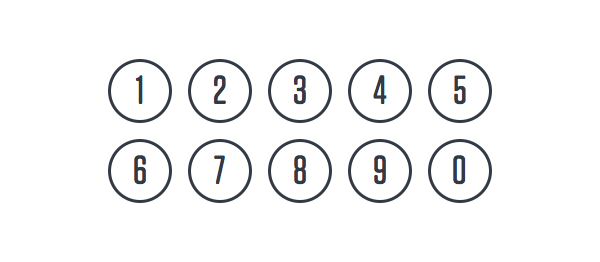
British keyboard 5-5-H, 1960s

The keyboard of one of the first 10-button punches IBM Model 011, 1940s
In connection with the two studies mentioned above, it is interesting to note the following: the letters never played a noticeable role in how the 10-button numeric keyboard will be arranged. People expressed a clear preference for the arrangement of numbers from left to right; with this approach, they showed the best speed and accuracy of work regardless of the arrangement of letters on the keys. The theories that such preferences will be based on the alphabetical order of the characters turned out to be incorrect. As a result, the telephone keypads that we use so far have come into use.
There are many factors that affect the design of devices, among these factors - technology and their limitations, ergonomics, user perception, and what they are used to. It seems that the last factor is the strongest, as it represents what people choose, making it into our digital era, when screen sizes are the only physical constraint for design ideas. Take a look at the applications of your iPhone or Android smartphone. You will easily find that the dial pad keypads and the calculator are arranged in the same way as the keyboards of devices similar to them, created hundreds of years ago.
Why is this so? The only rational explanation for the fact that software developers still adhere to similar standards in designing keyboards is that people will be more willing to work with their familiar interfaces than they will learn something new. These interfaces may have reached the maximum level of optimization that the interface may have.
In fact, it is very interesting to note that in earlier versions of Android and iOS, the telephone keypad was used as a standard interface for entering numbers into various fields, for example, on web pages.

Android 6 phone keyboard (left) and iOS 9 (right) ( inputtypes.com )
In more modern versions of iOS, instead of such a keyboard, a panel of special characters is offered.
On the other hand, if you analyze the Oculus Go, it turns out that here the calculator keyboard is used to enter any numbers (I tested it in a web application).
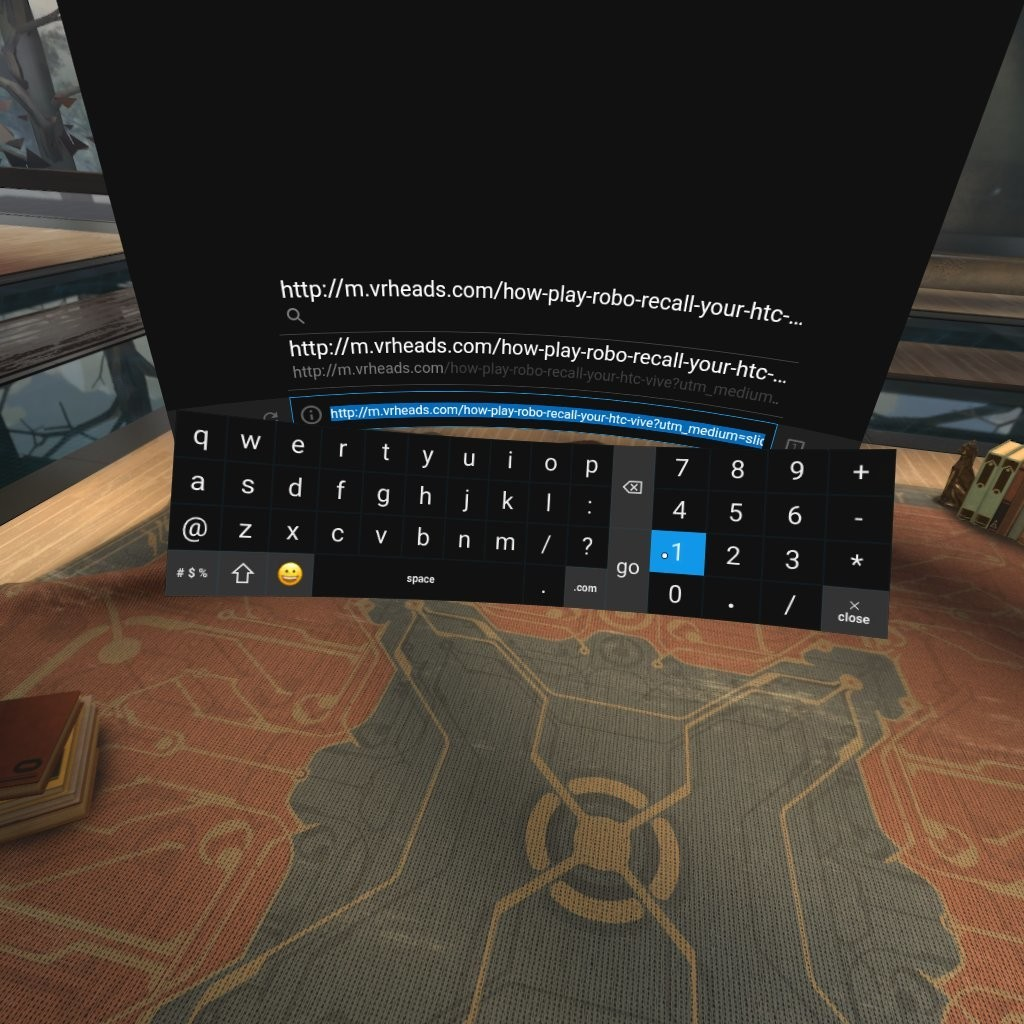
Oculus Go Keyboard , 2018
Why did Apple and Google prefer to use the traditional phone keypad and even keep the letters under the numbers? Why not create a special numeric keypad optimized for working with it with the thumb of one hand? Why for virtual reality was not created a special keyboard, which is easier to work using pointing devices? Taking into account the fact that none of the two classic layouts of digital keyboards did not give an advantage in speed of work, their only advantage was the ease of their perception. It is likely that the reasons for using existing layouts in programs are that they are simple to implement, and that they use the existing patterns of human-machine interaction in software. Smartphones keep the legacy of conventional push-button phones.
Dear readers! Do you think it is possible, in the foreseeable future, to expect the appearance of new layouts of digital keyboards that have a chance to become as popular as the existing ones?


Phone keypad (left) and calculator keypad (right)
As you can see, there is an insignificant but mysterious difference between these keyboards, given that they serve the same purpose — the input of numbers. Working with these keyboards looks exactly the same, so the reason for their differences is not quite clear. Common sense suggests that some technological limitations have played a role. Perhaps the keyboard looks like this because of the patent struggle between the inventors. Someone might try to explain the difference between them with ergonomic considerations.
I believe that the answer to the question about the reasons for the differences in digital keyboards will help to find the history of the evolution of the devices with which they were supplied. Going deeper into history, we will be able to find out which device was first invented, which keyboard influenced the other, and, more importantly, who first came up with the numeric keypad.
Typewriters, cash registers and calculators
Once I looked at the keyboard and I wanted to know when, in the history of cars, the use of keys began. The keyboard appeared roughly between the first and second industrial revolutions (between 1820 and 1920). And some inventors have already started experimenting with piano-like machines in the late 18th century.
The year of the appearance of the keyboard can be considered 1844, when the Frenchman Jean-Baptiste Schwilge created the first working prototype of a calculating machine with a keyboard. This machine used the world's first numeric keypad, which is a single row of keys with numbers from 1 to 9 on them.

The keyboard of the Jean-Baptiste Schwilge counting machine, 1844
For the sake of justice, however, two predecessors of Schwilge should be mentioned, which could be said that the human-machine interface based on the numeric keypad was invented by them. So, in 1834, Luigi Torquay, as reported, demonstrated a prototype of a wooden counting machine, the device of which resembled a typewriter. In 1822, James White, in his book “A new century of inventions ...,” described a device using a keyboard with nine numeric keys. Neither device has reached our days, we have no evidence that they were not only the fruit of someone's imagination.

The keyboard of the counting device described by James White, 1822 The
White machine, even if it existed only on paper, may well be considered the earliest example of a modern interface with direct control. This interface allows users to focus on working with the input device, without requiring them to interact with the internal mechanisms of the machine. Such an approach differs from that used in the Pascal summing machine or in the calculator for Thomas de Colmar.
It should be noted that these "ideas" still do not give us an explanation of why modern calculators use the keyboard with the reverse arrangement of numbers from 9 to 0.
There is an opinionaccording to which calculators are designed on the model of cash registers. This is worth pondering, since the numbers that had to be entered on such machines, representing certain sums of money, contained many zeros, which made the 0 key, which was most often pressed. Therefore, it made sense to place it at the very bottom of the keyboard so that it was as close as possible to the fingers of the operator.
Although this explanation probably contains some truth, the argument, based on the fact that it is easier to reach the zero, located at the bottom of the keyboard, is rather weak and does not withstand the test of facts. This is especially obvious if we consider that in the early models of cash registers that existed before 1893, there was no separate key 0 and there was no box for cash. In addition, the work with such devices was not organized as it is now.
In order to understand the relationship of calculators with cash registers, you need to refer to the history of the latter.
In 1897, James Ritty, the owner of a bar in Dayton (Ohio, USA), found that some of his employees were stealing. One day, he saw the steamer shaft speed counter, and, impressed by this spectacle, he invented a machine that used a set of numeric keys and something like an hour dial. The ancestor of modern cash registers was not designed for calculations. He allowed to record sales information and notify them with a call to the store manager.
Early cash registers that existed before 1983 had keyboards, usually consisting of one or two horizontal rows of keys, representing values such as 10, 15, 20, 30, 35, and so on. These numbers corresponded to the prices of goods sold in stores and bars, expressed in cents. Three vertical rows of keys appeared only with the release in 1894 of the NCR Model 79.

Keyboard of the first cash register by James Ritty, 1883
It should be noted that there are earlier evidence indicating the invention of the vertical layout of keys.
In 1884, Dorr Felt had an interesting idea for a machine that could operate with large numbers. When this idea developed enough, he decided to implement it, for a start, using what was at hand, including a wooden box from under the macaroni, which played the role of the body of his car, called comptometer. Comptometer had eight columns of keys with numbers from 9 (above) to 1 (below). Each column represented a decimal position. Remember that 0 is still not present in the key sequence.
Meanwhile, cash registers continued to evolve.

Comptometer Keyboard, 1885
And here the story is getting more interesting. Why did Felt decide to use a keyboard with a sequence of numbers from 9 to 1 to represent numbers? At that time, such an arrangement of keys could not be called familiar. In the end, then the knowledge of arithmetic machines was not particularly common.
An acceptable answer to this question can be compared with some mechanical design solutions, possibly associated with the method of additions , and with the fact that the keys set in motion the levers associated with the rotating drums. The longer the lever - the more the drum turns. The longest lever, therefore, corresponded to the number 9, and the shortest lever - to the number 1. The same principle, before Felt, applied Parmeli.
Here is another approach to answering the question about the arrangement of numbers on the keys of a comptometer. It is based on modern design principles and goes beyond the idea of explaining everything with purely mechanical features of the device. So, in accordance with the instructions for comptometer, it was assumed that the operators, in order to enter "9 cents", will not press the 9 key in the rightmost column. Instead, they would press, successively, the keys 4 and 5, and the car would add these numbers. It was not recommended to reach the key 9 in such a situation, as this would reduce the speed of calculations due to the fact that the operator would have to move the right hand, located in the lower part of the keyboard, to its upper part. Felt attached great importance to efficiency. This meant that the keys used most often had to be within the reach of the operator’s fingers. There is a feeling that the desire for efficiency led to exactly this arrangement of the keys of the comptometer, but the data entry interfaceThis machine can not be considered easy to learn and use.
To achieve maximum productivity when working with comptometer and competing machines, we needed well-trained operators. In addition, especially when it came to multiplication, it was difficult to work with such devices with one hand.
In 1902, Dalton’s calculating machine appeared , which became the most popular 10-key machine of the time, making calculators less popular and having multi-column keyboards. This device was a smaller version of a typewriter, its keys were arranged in two rows, five each. The keyboard layout looked strange: in the upper row were the numbers 24579, and in the bottom row - 13068. What is special to notice in the keyboard of this device?
Surely you already understood it. There appeared 0, which we have not seen in the previously discussed keyboards.

Dalton's Keyboard Machine, 1902
Dalton's machine, in addition to a new type of keyboard that does not require the use of separate keys to enter each digit of the decimal number, also had a built-in printer. Accountants around the world could not get enough of such a useful invention. But, after the appearance of this machine, the development of devices for carrying out calculations, of course, did not stop.
In 1914, David Sundstrand, an American of Swedish descent, filed a patent application (No. 1198487). The purpose of this patent was to improve the usability of summing machines. Sandstrand changed the location of the keys, making it more "logical and natural." The new keyboard layout was based on the main block of 9 keys, containing 3 keys vertically and 3 horizontally. In the very top row of this block were the numbers 7-8-9. Below this block, there was an increased 0 key. It was possible to work with such a keyboard with one hand, which made it “the fastest keyboard among the keyboards of all calculating machines”.

SANDSTRAND'S MACHINE KEYBOARD, 1914
It is this layout that has become the standard for calculators, which is relevant even now, when more than a hundred years have passed since its inception.
Path from calculators to phones
Can we say that calculators, in the course of their evolution, have influenced modern phones? Perhaps this is so, but it is impossible to give an exact answer to this question. Experiments with push-button telephones were carried out back in 1887, at Bell Telephone Company, which was at the origin of telephone communications. This was prior to the invention of the disk dialer by Elmon Brown Strouger. The company Western Electrics entered the commercial operation of the device in 1919. This continued until the 1950s, when the automatic long-distance telephone service significantly spread. Local numbers (usually consisting of six or fewer digits) have been expanded to seven-digit numbers. Long-distance call led to the need to dial 11 numbers.
Increasing the length of phone numbers has increased the number of errors when making calls, which made AT & T engineers think about whether this is due to the inconvenience of the keyboard used by telephone service operators .

The keyboard layout used in telephone services in the 1950s
In 1955, a study was conductedconcerning the arrangement of characters on a ten-button keyboard, then, in 1960, another similar study of telephone keyboardswas carried out. The findings of these studies contained information that could have an impact on the design of a modern phone. AT & T was going to switch to tone dialing, which implied the use of devices equipped with a keyboard for dialing. It was important to determine what configuration of the keyboard is best suited for subscribers.

Keyboard layouts tested in a 1960 study.
The company experienced 15 layouts using, among other things, unusual looking diagonal, pyramidal, circular, and horizontal ways of organizing keys. This included the layouts used in existing devices, such as calculators and punchers like the IBM Model 011. Unexpectedly, the calculator's keyboard did not perform well here. The subjects preferred the keyboard, on which the numbers are located from left to right and from top to bottom.
In particular, working with a 2-row horizontal keyboard (5-5-H) was just as fast as with a modern looking keyboard with a 3x3 + 1 layout, the differences between them were very small. AT & T chose the 3x3 + 1 layout, perhaps because it is more compact and versatile.
Note the word "possible" in the previous sentence. It is useful to us and a little lower. Both studies did not give a definitive answer to the question of the perfect keyboard. And in the UK they started using the 5-5-H type keyboard, possibly due to patent restrictions.

British keyboard 5-5-H, 1960s

The keyboard of one of the first 10-button punches IBM Model 011, 1940s
In connection with the two studies mentioned above, it is interesting to note the following: the letters never played a noticeable role in how the 10-button numeric keyboard will be arranged. People expressed a clear preference for the arrangement of numbers from left to right; with this approach, they showed the best speed and accuracy of work regardless of the arrangement of letters on the keys. The theories that such preferences will be based on the alphabetical order of the characters turned out to be incorrect. As a result, the telephone keypads that we use so far have come into use.
Constructive solutions and generally accepted standards
There are many factors that affect the design of devices, among these factors - technology and their limitations, ergonomics, user perception, and what they are used to. It seems that the last factor is the strongest, as it represents what people choose, making it into our digital era, when screen sizes are the only physical constraint for design ideas. Take a look at the applications of your iPhone or Android smartphone. You will easily find that the dial pad keypads and the calculator are arranged in the same way as the keyboards of devices similar to them, created hundreds of years ago.
Why is this so? The only rational explanation for the fact that software developers still adhere to similar standards in designing keyboards is that people will be more willing to work with their familiar interfaces than they will learn something new. These interfaces may have reached the maximum level of optimization that the interface may have.
In fact, it is very interesting to note that in earlier versions of Android and iOS, the telephone keypad was used as a standard interface for entering numbers into various fields, for example, on web pages.

Android 6 phone keyboard (left) and iOS 9 (right) ( inputtypes.com )
In more modern versions of iOS, instead of such a keyboard, a panel of special characters is offered.
On the other hand, if you analyze the Oculus Go, it turns out that here the calculator keyboard is used to enter any numbers (I tested it in a web application).

Oculus Go Keyboard , 2018
Why did Apple and Google prefer to use the traditional phone keypad and even keep the letters under the numbers? Why not create a special numeric keypad optimized for working with it with the thumb of one hand? Why for virtual reality was not created a special keyboard, which is easier to work using pointing devices? Taking into account the fact that none of the two classic layouts of digital keyboards did not give an advantage in speed of work, their only advantage was the ease of their perception. It is likely that the reasons for using existing layouts in programs are that they are simple to implement, and that they use the existing patterns of human-machine interaction in software. Smartphones keep the legacy of conventional push-button phones.
Chronology
- 1642: Blaz Pascal Summing Machine.
- 1822: The concept of James White's computer with keys.
- 1844: Schwilge counting machine - a numeric keypad is used for the first time in history.
- 1857: Thomas Hill machine, the forerunner of comptometer.
- 1874: E. Remington and Sons begins production of the Schwolz and Gliddenin typewriter.
- 1879: The first cash register in history created by James Ritty.
- 1885: Comptometer, in which the keyboard is first used with the numbers in columns from 9 to 1.
- 1887: Early prototypes of push-button telephones.
- 1887: Cash register NCR Model 79 using a vertical layout.
- 1902: Dalton's first counting machine, using a 10-button numeric keypad.
- 1914: A 10-button Sundstrand counting machine using a 3x3 + 1 keyboard layout.
- 1919: Western Electric & AT & T introduces dialing phones.
- 1940: A division operation appears in the calculator Olivetti Dividisumma.
- 1940: IBM punch with a 10-button keyboard, in the top row of which are the numbers 1-2-3.
- 1955: AT & T begins testing push-button phones.
- 1963: Bell introduces 10-button telephones.
- 1963: Canon introduces the prototype of the first electronic calculator with a display.
- 1966: Sharp / Facit established the production of electronic calculators with a display.
- 2007: Apple released the iPhone, which had a calculator application.
Dear readers! Do you think it is possible, in the foreseeable future, to expect the appearance of new layouts of digital keyboards that have a chance to become as popular as the existing ones?

